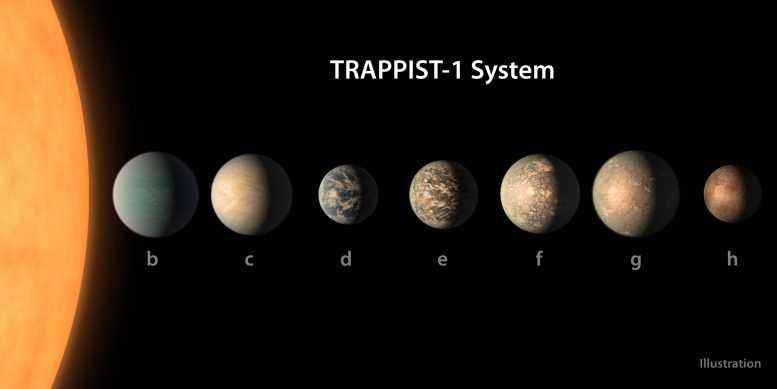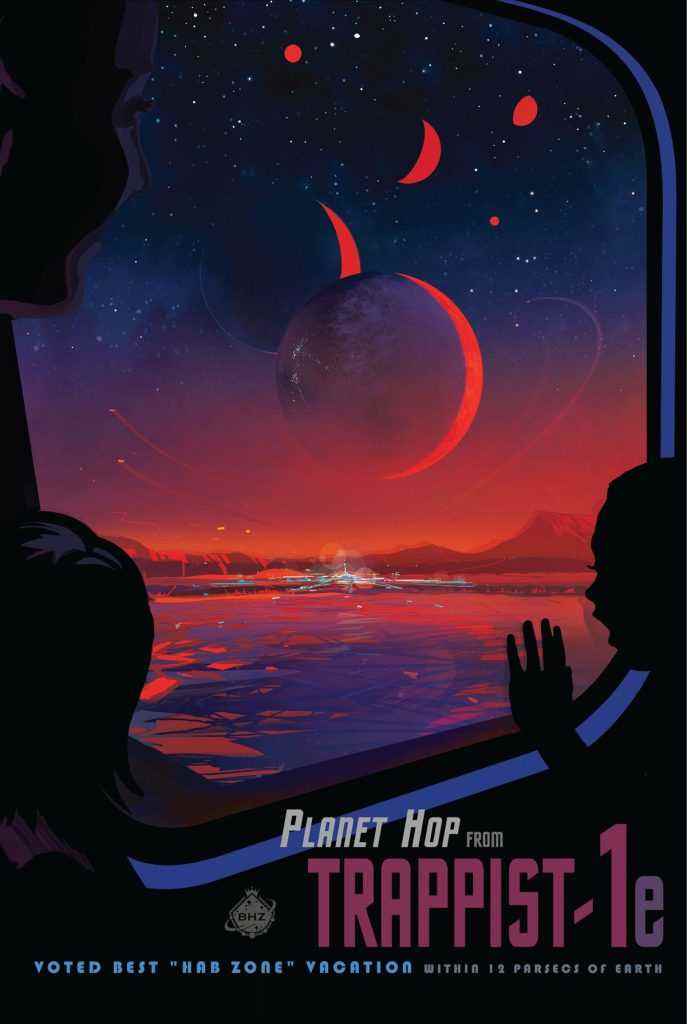Bu sanatçının konsepti, Dünya’dan 40 ışıkyılı uzaklıkta bulunan TRAPPIST-1 sistemi içindeki yedi kayalık ötegezegeni tasvir ediyor. Kredi: NASA ve JPL/Caltech
Beş yıl önce, gökbilimciler diğer dünyaların muhteşem bir koleksiyonunu ortaya çıkardılar: TRAPPIST-1 sistemi.
Dünyanın dört bir yanındaki gazeteler, keşfi ön sayfalarında yayınladılar: Gökbilimciler, TRAPPIST-1 adlı kırmızı bir cüce yıldızın, birbirine bağlı yedi Dünya boyutunda gezegenden oluşan bir aileye ev sahipliği yaptığını bulmuşlardı.[{” attribute=””>NASA announced the system on February 22, 2017.
Using telescopes on the ground and in space, scientists revealed one of the most unusual planetary systems yet found beyond our Sun and opened the tantalizing question: Are any of these worlds habitable – a suitable home for life?
Five years later, the planets are still enigmatic. Since the first announcement, subsequent studies have revealed that the TRAPPIST-1 planets are rocky, that they could be almost twice as old as our solar system, and that they are located 41 light-years from Earth.

This illustration shows what the TRAPPIST-1 planetary system may look like, based on available data about the planets’ diameters, masses, and distances from the host star. Astronomers have named them the planets TRAPPIST-1a, TRAPPIST-1b, and so forth. Credit: NASA/JPL-Caltech
But a real game-changer will be the recently launched James Webb Space Telescope. Larger and more powerful than any previous space telescope, Webb will look for signs of atmospheres on the TRAPPIST-1 planets.
“That folks are even able to ask the question about whether a planet around another star is habitable – that just boggles my mind,” said Sean Carey, manager of the Exoplanet Science Institute at NASA’s Jet Propulsion Laboratory in Southern California. Carey was part of the team that helped discover some of the TRAPPIST-1 planets using data from the now-retired Spitzer Space Telescope.
A prime target for Webb is the fourth planet from the star, called TRAPPIST-1e. It’s right smack in the middle of what scientists call the habitable zone, also known as the Goldilocks zone. This is the orbital distance from a star where the amount of heating is right to allow liquid water on the surface of a planet.
Though the planets are tightly packed around TRAPPIST-1, the red dwarf star is not only far cooler than our Sun, it is less than 10% its size. (In fact, if the entire system were placed in our own solar system, it would fit within the orbit of our innermost planet, Mercury.)

You won’t be able to visit TRAPPIST-1 e any time soon, but you can imagine the sojourn with this free downloadable travel poster. It’s from a series of travel posters from JPL that imagine virtual trips to 14 alien worlds. Credit: NASA/JPL-Caltech
Searching for Atmospheres
The habitable zone is just a first cut. A potentially habitable planet also would require a suitable atmosphere, and Webb, especially in its early observations, is likely to gain only a partial indication of whether an atmosphere is present.
“What is at stake here is the first atmosphere characterization of a terrestrial Earth-size planet in the habitable zone,” said Michaël Gillon, an astronomer at the University of Liege in Belgium and the lead author of the study that revealed the seven sibling planets in 2017.
Measurements with the Hubble Space Telescope added more information about habitability. While Hubble does not have the power to determine whether the planets possess potentially habitable atmospheres, it did find that at least three of the planets – d, e, and f – do not appear to have the puffy, hydrogen-dominated atmospheres of gas giants, such as Neptune, in our solar system. Such planets are thought to be less likely to support life.
That leaves open the possibility of “the atmospheres’ potential to support liquid water on the surface,” said Nikole Lewis, a planetary scientist at Cornell University.
Lewis is part of a science team that will use the Webb telescope, which will view the heavens in infrared light, to hunt for signs of an atmosphere on TRAPPIST-1e, the one with the Goldilocks perch in the habitable zone.
“The hope is that we see carbon dioxide, a really strong feature, right at the wavelengths [detectable by] Webb,” dedi. “Gürültünün üzerinde yükselen küçük şeylerin nerede olduğunu öğrendikten sonra, geri dönüp o bölgeye çok daha yüksek çözünürlüklü bir bakış yapabiliriz.”
TRAPPIST-1 gezegenlerinin boyutu, araştırma kesin olmaktan uzak olsa da, yaşanabilirlik durumunu güçlendirmeye yardımcı olabilir.
Sadece çap olarak değil kütle olarak da Dünya ile karşılaştırılabilirler. Gezegenlerin kütlesini daraltmak, TRAPPIST-1’in etrafındaki sıkı kümelenmeleri sayesinde mümkün oldu: Omuz omuza, birbirlerini iterek, bilim adamlarının bu kütleçekim etkilerinden olası kütle aralıklarını hesaplamalarını sağladılar.
Cornell’den Lewis, “Boyutları – kütle ve yarıçap hakkında gerçekten iyi bilgiler aldık” dedi. “Bu, yoğunluklarını bildiğimiz anlamına geliyor.”
Yoğunluklar, gezegenlerin Dünya gibi karasal gezegenlerde bulunan malzemelerden oluşabileceğini gösteriyor.
Lewis, bilim adamlarının olası gezegen atmosferi oluşumu ve evriminin bilgisayar modellerini olası bileşimlerini daraltmaya çalışmak için kullandıklarını ve bunların TRAPPIST-1 gezegenleri için kritik olacağını söyledi.
“TRAPPIST sistemiyle ilgili en güzel şey, bu modelleri her iki şekilde de iyileştirmemize izin vermesidir – ister çorak kaya olsun ister potansiyel olarak yaşanabilir dünyalar olsun,” dedi.
Gillon için sistemle ilgili bir başka harika şey de TRAPPIST-1 sisteminin erişimidir. “TRAPPIST-1’in bazı sanatsal çalışmalarda yer aldığını gördüm; Bunu müzikte, bilimkurgu romanlarında, çizgi romanlarda gördüm” dedi. “Bu, beş yıl boyunca gerçekten keyif aldığımız bir şey. Sanki bu sistemin kendine ait bir hayatı var.”

